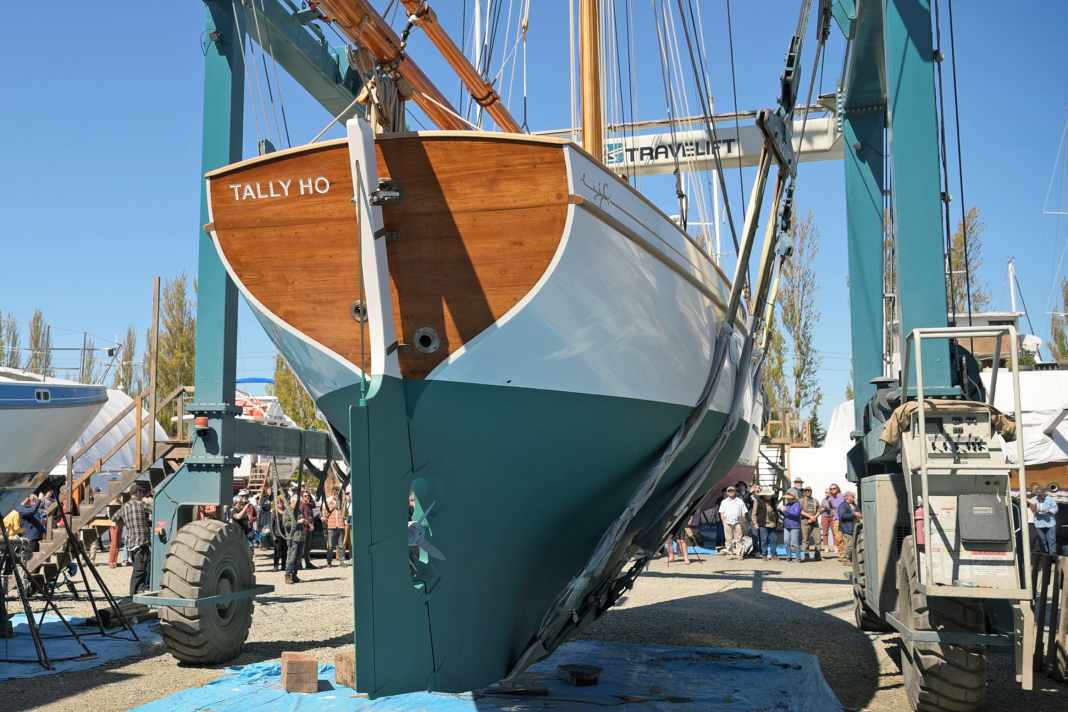





You can only keep your hands off such a mammoth project. But Goolden's ability to suffer, coupled with unshakeable optimism and a hands-on mentality, have driven the project forwards continuously. To finance the project, he fed his YouTube channel, which now has almost 500,000 subscribers, with an elaborate video every fortnight. With his enthusiasm and British humour, the boat builder also inspires many people who have nothing to do with sailing or boat building.
One of the countless comments from his fans: "Why did I just spend six years watching a man build a boat? I think I understand now. It's because Leo is such a masterful and effortless teacher. He taught me to love boats, to love fine woodworking and to appreciate sailing."
The launching, including a summary of the last night ashore, during which work continued non-stop, is also documented in a film worth seeing. Video to see. With absolute dedication and obsession for detail, he paints and decorates right up to the last minute until the cutter finally hangs in the crane. As the work is still far from complete, there will be many more videos for his loyal followers to see.
A life full of adventure
Goolden's entire life story is like a script for a gripping film. After spending two years travelling through South East Asia, Australia and New Zealand as a street musician, he decides to start an apprenticeship as a boat builder in his home country. The apprenticeship is tough and initially unpaid, but prepares him mentally for his later adventures. For months, he struggles through life penniless and lives almost like a clochard. Thanks to nightly side jobs, he still manages to save some money, which he spends on his first boat, a Manta 19, in a hangover mood.
He actually wanted to cross the Atlantic in the 5.80 metre long centreboard boat, but Goolden was persuaded to swap his first vessel for a rotten folk boat. He refits it at a boatyard in Cornwall and in 2015 actually sails single-handed across the pond without a GPS or engine. Once he arrived in the Caribbean, he also won the Antigua Classic Yacht Regatta with his Folke and was honoured as the best young skipper. He later worked as a mate on the luxury three-masted schooner "Adix" and even skippered a 90-foot ketch from Antigua via Greenland to Europe. By then he had already acquired the RYA Yachtmaster Ocean and was authorised to skipper sailing yachts up to 200 tonnes.
He says of his restoration project with the "Tally Ho": "It was a scary thing to tackle. But I'm an optimist, otherwise I wouldn't have done it. I had the same feeling as when I bought the Folke. Or when I crossed the Atlantic. Or when I set off to India alone at the age of 18. All scary decisions, but the ones that ultimately gave me the most satisfaction in my life."
The story of the "Tally Ho"
Designed by the well-known English designer and artist Albert Strange, the gaff cutter was launched in 1910 at Stow & Son in Shoreham-by-Sea in the south of England as the "Betty". It was commissioned by the British cruising sailor Charles Hellyer, who wanted a ship that he could also use for fishing. Three years later, Hellyer had a larger ship built and sold "Betty" again. In a roundabout way, she came into the possession of Lord Stalbridge in 1927, who renamed her "Tally Ho", an exclamation used in fox hunting and a name for fast carriages. After a modification, she took part in the third edition of the Fastnet Race in the same year, in the stormy course of which all but two yachts gave up. Only the Alden schooner "La Goleta" and the "Tally Ho" finished the race and fought a thrilling battle for first place. Even though "Tally Ho" crossed the finish line 52 minutes later, that was easily enough to win according to the calculated time. Fishing and cruising remained the yacht's dominant uses over the following decades, until it ran aground on a reef in the South Pacific near the Cook Islands. Severely damaged, she was salvaged, repaired and rebuilt to serve as a fishing vessel on the US West Coast. After being decommissioned, the ship was wrecked. With the help of the Albert Strange Association and Leo Goolden, who acquired it in 2017 for a symbolic price of one pound sterling, the final end was averted. Seven years later, she is now being launched again.
Technical data
- Designer: Albert Strange
- Shipyard: Stow & Son
- Year of construction: 1910
- Length: 14.5 m
- Width: 4.0 m
- Draught: 2.3 m
- Displacement: 28 tonnes
- Ballast: 12 tonnes
- Sail area: 154 square metres

